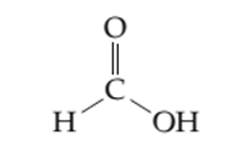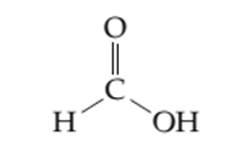
Concept explainers
(a)
Interpretation:
Thesimplified orbital overlap picture needs to be drawnto indicate the p system and localized lone pairs of the given molecule.

Concept introduction:
Organic compounds are the compounds which are mainly composed C and H atoms. The branch of chemistry that deals with preparation, reactions, and properties of organic compounds. The molecular formula of organic compound represents the number of bonded atoms with their atomic symbols.
(b)
Interpretation:
The localized lone pairs and delocalized lone pairs in the given molecule needs to be determined.

Concept introduction:
Organic compounds are the compounds which are mainly composed C and H atoms. The branch of chemistry that deals with preparation, reactions, and properties of organic compounds. The molecular formula of organic compound represents the number of bonded atoms with their atomic symbols.
Functional groups are the groups of atoms or atoms which are bonded with parent carbon chain in the organic molecule and are responsible for the physical and chemical properties of the compound. In organic chemistry, there are different functional groups such as carboxylic acid, alcohol, ester, or amide.
(c)
Interpretation:
Theresonance structure of the given molecule needs to be determined.

Concept introduction:
Organic compounds are the compounds which are mainly composed C and H atoms. The branch of chemistry that deals with preparation, reactions, and properties of organic compounds. The molecular formula of organic compound represents the number of bonded atoms with their atomic symbols.
Functional groups are the groups of atoms or atoms which are bonded with parent carbon chain in the organic molecule and are responsible for the physical and chemical properties of the compound. In organic chemistry, there are different functional groups such as carboxylic acid, alcohol, ester, or amide.
Want to see the full answer?
Check out a sample textbook solution
Chapter 23 Solutions
CHEMISTRY-TEXT
- The partial Lewis structure that follows is for a hydrocarbonmolecule. In the full Lewis structure, each carbon atomsatisfies the octet rule, and there are no unshared electronpairs in the molecule. The carbon—carbon bondsare labeled 1, 2, and 3. (a) How many hydrogen atomsare in the molecule? (b) Rank the carbon–carbonbonds in order of increasing bond length. (c) Whichcarbon—carbon bond is the strongest one? [Sections 8.3and 8.8]arrow_forwardConsider compounds A–D, which contain both a heteroatom and a double bond. (a) For which compounds are no additional Lewis structures possible? (b) When two or more Lewis structures can be drawn, draw all additional resonance structures.arrow_forwardDraw the shapes of the following molecules and ions in 3-dimension. Show clearly any lone pairs of electrons on the central atom, state the number of bond pairs and lone pairs of electrons on the central atom and name the shape of the molecule or ion. (a) SiCI4, silicon tetrachloride (b) PBr3, phosphorus tribromide (c) CI2O, dichlorine oxide Provide everything stated in the instructions for each compound.arrow_forward
- Draw a Lewis structure for each of the following molecule: (a) chlorodifluoromethane, CHCIF2 (b) propanoic acid C2H5CO2H (basic structure pictured below) (c) acetonitrile, CH3CN ( the framework is H3C-C-N) (d) allene, H2CCCH2arrow_forwardThe structure at the right is a skeleton of an anion having the overall formula C6H,NO¯. The hydrogen atoms are not shown. (a) Draw a complete Lewis structure in which the -1 formal charge is on N. Include all H atoms and C. valence electrons. (b) Do the same for a Lewis structure with the -1 formal charge on O. (c) Do the same for a Lewis structure with the -1 formal charge on the C atom that is bonded to three other C atoms.arrow_forwardCompute the formal charge (FC) on each atom in the following structures. (b) The hydronium ion, H3O+arrow_forward
- The curved arrow notation introduced in Section 1.6B is a powerfulmethod used by organic chemists to show the movement of electronsnot only in resonance structures, but also in chemical reactions.Because each curved arrow shows the movement of two electrons,following the curved arrows illustrates what bonds are broken andformed in a reaction. Consider the following three-step process. (a) Addcurved arrows in Step [1] to show the movement of electrons. (b) Use thecurved arrows drawn in Step [2] to identify the structure of X. X isconverted in Step [3] to phenol and HCl.arrow_forward(a) Draw all resonance contributors of the following ion. In drawing each additional resonance structure, use curved arrows to indicate which pairs of electrons are being shifted. (b) Draw the resonance hybrid. (c) Which c–C bond is the longest?arrow_forward(a) Complete the Lewis structure for vinyl chloride by showing all unshared pairs of electrons. (b) Predict the H-C-H, H-C-C, and Cl-C-H bond angles in this molecule. (c) Does vinyl chloride have polar bonds? Is it a polar molecule? Does it have a dipole?arrow_forward
- The curved arrow notation introduced in Section 1.6B is a powerful method used by organic chemists to show the movement of electrons not only in resonance structures, but also in chemical reactions.Because each curved arrow shows the movement of two electrons, following the curved arrows illustrates what bonds are broken and formed in a reaction. Consider the following three-step process. (a) Add curved arrows in Step [1] to show the movement of electrons. (b) Use the curved arrows drawn in Step [2] to identify the structure of X. X is converted in Step [3] to phenol and HCl.arrow_forwardThe following are partial Lewis structures for neutral organic compounds. How many lone pairs would be present in a complete Lewis structure for a , b , and c below? (a) (b) (c) 'N. H Narrow_forwardProblem Draw a Lewis structure and identify the octet-rule exception for (a) H3PO4 (draw two resonance forms and select the more important); (b) BFCl2.Plan We draw each Lewis structure and examine it for exceptions to the octet rule.(a) The central atom is in Period 3, so it can have more than an octet.(b) The central atom is B, which can have fewer than an octet of electrons.arrow_forward
 ChemistryChemistryISBN:9781305957404Author:Steven S. Zumdahl, Susan A. Zumdahl, Donald J. DeCostePublisher:Cengage Learning
ChemistryChemistryISBN:9781305957404Author:Steven S. Zumdahl, Susan A. Zumdahl, Donald J. DeCostePublisher:Cengage Learning ChemistryChemistryISBN:9781259911156Author:Raymond Chang Dr., Jason Overby ProfessorPublisher:McGraw-Hill Education
ChemistryChemistryISBN:9781259911156Author:Raymond Chang Dr., Jason Overby ProfessorPublisher:McGraw-Hill Education Principles of Instrumental AnalysisChemistryISBN:9781305577213Author:Douglas A. Skoog, F. James Holler, Stanley R. CrouchPublisher:Cengage Learning
Principles of Instrumental AnalysisChemistryISBN:9781305577213Author:Douglas A. Skoog, F. James Holler, Stanley R. CrouchPublisher:Cengage Learning Organic ChemistryChemistryISBN:9780078021558Author:Janice Gorzynski Smith Dr.Publisher:McGraw-Hill Education
Organic ChemistryChemistryISBN:9780078021558Author:Janice Gorzynski Smith Dr.Publisher:McGraw-Hill Education Chemistry: Principles and ReactionsChemistryISBN:9781305079373Author:William L. Masterton, Cecile N. HurleyPublisher:Cengage Learning
Chemistry: Principles and ReactionsChemistryISBN:9781305079373Author:William L. Masterton, Cecile N. HurleyPublisher:Cengage Learning Elementary Principles of Chemical Processes, Bind...ChemistryISBN:9781118431221Author:Richard M. Felder, Ronald W. Rousseau, Lisa G. BullardPublisher:WILEY
Elementary Principles of Chemical Processes, Bind...ChemistryISBN:9781118431221Author:Richard M. Felder, Ronald W. Rousseau, Lisa G. BullardPublisher:WILEY





